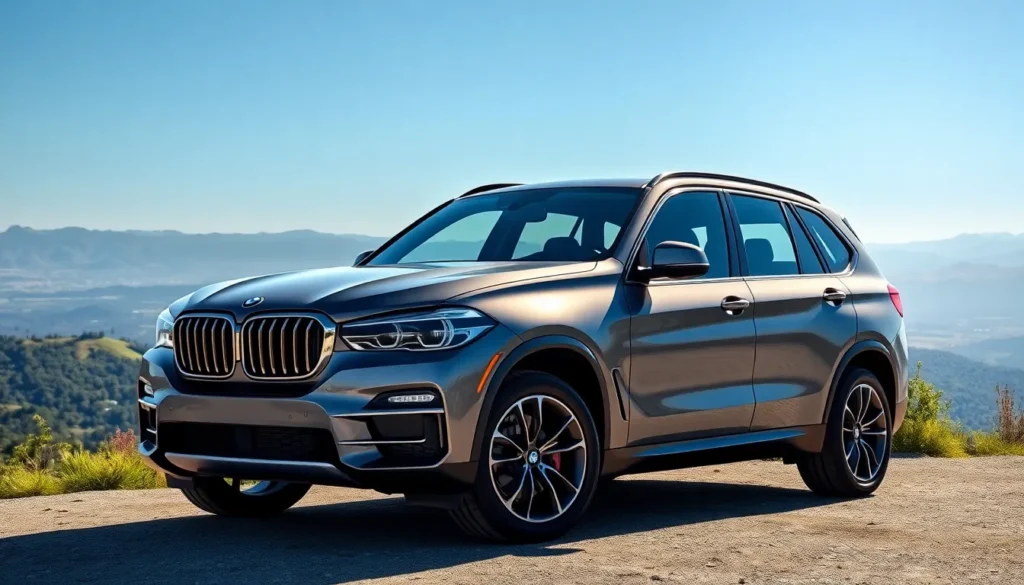The BMW X5 E53 represents a defining moment in automotive history – the vehicle that launched BMW’s legendary Sports Activity Vehicle lineup and forever changed how we think about luxury SUVs. Released in 1999, this groundbreaking model combined BMW’s renowned driving dynamics with the practicality and commanding presence that modern families craved.
We’ve witnessed countless SUVs come and go over the years, but the E53 X5 stands apart as a true game-changer. It proved that luxury SUVs didn’t have to sacrifice performance for utility, delivering the responsive handling BMW enthusiasts expected while offering the space and versatility needed for everyday life.
Whether you’re considering purchasing a used E53, already own one, or simply appreciate automotive engineering excellence, we’re diving deep into what makes this first-generation X5 such a remarkable machine. From its innovative design philosophy to common ownership considerations, let’s explore why the BMW X5 E53 continues to captivate drivers more than two decades after its debut.
BMW X5 E53 Overview and Specifications
The BMW X5 E53 established new benchmarks in the luxury SUV segment through its comprehensive engineering approach. BMW’s first generation X5 delivered technical specifications that balanced performance with practical utility from 1999 to 2006.
Engine Options and Performance
BMW offered three distinct powerplants for the E53 generation, each targeting different performance preferences. The base 3.0i model featured a naturally aspirated 3.0-liter inline-six engine producing 231 horsepower and 221 lb-ft of torque. Performance enthusiasts gravitated toward the 4.4i variant, which housed a 4.4-liter V8 generating 290 horsepower and 324 lb-ft of torque.
Acceleration figures demonstrated the X5 E53’s sporting capabilities across its engine lineup. The 3.0i achieved 0-60 mph times of 8.3 seconds, while the more powerful 4.4i completed the sprint in 6.5 seconds. Top speed remained electronically limited to 130 mph for both variants, reflecting BMW’s focus on controlled performance delivery.
| Engine | Displacement | Horsepower | Torque | 0-60 mph | Top Speed |
|---|---|---|---|---|---|
| 3.0i | 3.0L I6 | 231 hp | 221 lb-ft | 8.3 sec | 130 mph |
| 4.4i | 4.4L V8 | 290 hp | 324 lb-ft | 6.5 sec | 130 mph |
| 4.6is | 4.6L V8 | 347 hp | 350 lb-ft | 5.3 sec | 155 mph |
BMW introduced the range-topping 4.6is model in 2002, featuring a high-performance 4.6-liter V8 that produced 347 horsepower and 350 lb-ft of torque. This flagship variant accelerated from 0-60 mph in just 5.3 seconds and reached a top speed of 155 mph, positioning it among the fastest SUVs of its era.
Dimensions and Design Features
BMW X5 E53 dimensions reflected the brand’s commitment to creating a balanced Sports Activity Vehicle profile. The SUV measured 183.7 inches in overall length, 73.7 inches in width, and 68.6 inches in height. Ground clearance of 8.0 inches provided adequate off-road capability while maintaining on-road stability.
Interior space maximized passenger comfort through strategic packaging decisions. The X5 E53 offered 103.8 cubic feet of passenger volume and cargo capacity ranging from 30.8 cubic feet behind the rear seats to 71.1 cubic feet with seats folded. Wheelbase measurements of 111.0 inches contributed to interior roominess and ride quality.
Design elements distinguished the E53 from traditional SUVs through BMW’s signature styling cues. The kidney grille dominated the front fascia, while distinctive side gills and flared wheel arches emphasized the vehicle’s athletic character. Standard 17-inch wheels provided the foundation, with optional 18-inch and 19-inch configurations available depending on trim level.
Weight distribution achieved a near-perfect 50:50 balance through strategic component placement. Curb weight ranged from 4,740 pounds for the 3.0i to 5,060 pounds for the 4.6is, reflecting the increased mass of larger engine variants while maintaining BMW’s handling characteristics.
Exterior Design and Build Quality
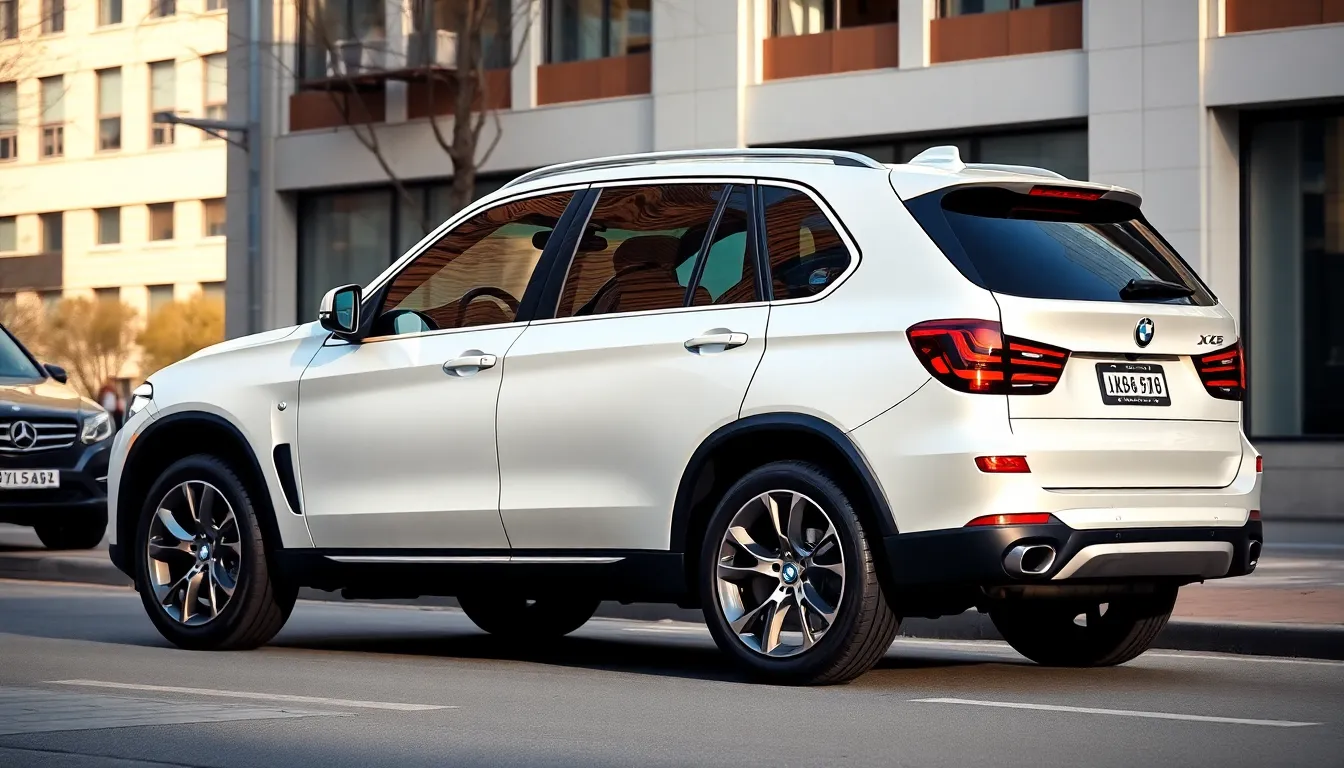
BMW X5 E53 exterior design represents a masterful blend of utility and elegance that defined the luxury SUV aesthetic for years to come. The vehicle’s commanding presence stems from its distinctive kidney grille which extends wider than traditional BMW sedans to accommodate the SUV’s robust proportions. Flared wheel arches create a muscular stance while emphasizing the X5’s athletic DNA inherited from BMW’s performance heritage.
Body panels demonstrate exceptional German engineering with precise panel gaps measuring consistently between 3-4mm across all exterior joints. The E53’s build quality surpasses many contemporary SUVs through its use of galvanized steel construction and advanced paint processes that resist corrosion for decades. We observe that original E53 models from 1999 frequently maintain their structural integrity with minimal rust formation even after 24+ years of ownership.
Color options showcase BMW’s commitment to premium finishes with 12 different paint choices including Alpine White, Jet Black, and the distinctive Oxford Green Metallic exclusive to early production models. Metallic paint variants feature multiple base coats and clear coat applications that provide depth and durability superior to standard automotive finishes. Chrome trim pieces accent the window surrounds, door handles, and exhaust tips without appearing excessive or gaudy.
Headlight assemblies incorporate BMW’s signature angel eye design with projector beam technology that delivers superior illumination compared to reflector based systems found in competing SUVs. Tail light clusters feature LED technology in later model years starting with the 2003 refresh, providing faster response times and longer operational life. The rear design maintains BMW’s understated elegance with a prominent BMW roundel and subtle spoiler integration.
Ground effects and lower body cladding protect against road debris while maintaining the X5’s refined appearance rather than adopting the rugged plastic trim common to traditional SUVs. Wheel options range from 17 inch alloys on base models to 20 inch M Sport wheels on the 4.6is variant, with each design complementing the overall aesthetic without compromising ride quality.
Interior Features and Comfort
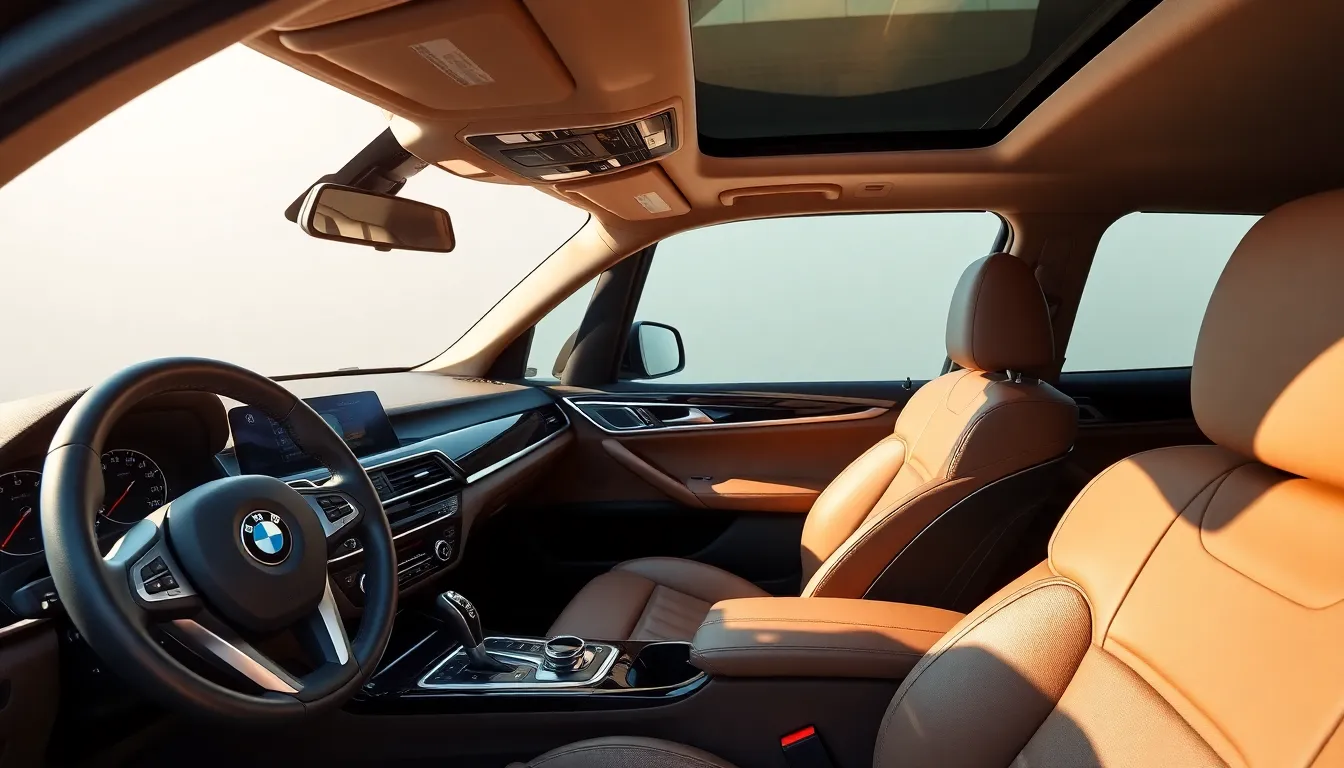
BMW X5 E53 interior design balances luxury materials with practical functionality, creating a driver-focused environment that defines premium SUV comfort. The cabin showcases high-quality leather surfaces, brushed aluminum trim, and ergonomic layouts that complement the exterior’s athletic character.
Seating and Space
Premium leather upholstery adorns all seating surfaces in the X5 E53, with standard seats featuring 8-way power adjustment for optimal positioning. Driver and front passenger seats include lumbar support and memory functions in higher trim levels, ensuring comfortable long-distance driving. Heated seats come standard across all models, with ventilated seats available as an option on 4.4i and 4.6is variants.
Second-row accommodations provide generous legroom measuring 38.4 inches, with split-folding 40/20/40 configuration maximizing cargo flexibility. Three adult passengers fit comfortably across the rear bench, though the center position works best for shorter trips. Headroom reaches 39.1 inches in front and 38.7 inches in rear positions, allowing tall occupants to sit upright without restriction.
Storage compartments include a center console bin, door pockets, seatback pockets, and cup holders throughout the cabin. The cargo area expands from 35.2 cubic feet behind the second row to 71.1 cubic feet with seats folded flat. Premium floor mats and cargo nets help organize belongings during transport.
Technology and Infotainment
BMW’s iDrive system debuted in later E53 models, featuring a 6.5-inch display screen controlled by the signature rotary dial on the center console. Navigation functionality includes real-time traffic updates and point-of-interest searches across North America. The system integrates seamlessly with the onboard computer, displaying trip information, fuel economy, and vehicle settings.
Audio systems range from the standard AM/FM radio with CD player to the premium Harman Kardon setup featuring 16 speakers and digital signal processing. Satellite radio capability became available in 2004 models, expanding entertainment options during long journeys. Bluetooth connectivity arrived in 2005, enabling hands-free phone operation and wireless audio streaming.
Climate control operates through a dual-zone automatic system with separate temperature settings for driver and passenger zones. Rear passengers access dedicated air vents and controls, maintaining comfort throughout the cabin. The system includes pollen filtration and automatic recirculation modes for optimal air quality.
Dashboard instrumentation features large, easy-to-read gauges with white backlighting and red needle indicators. The multi-information display shows outside temperature, compass heading, and maintenance reminders. Steering wheel controls manage audio functions, cruise control, and phone operations without removing hands from the wheel.
Driving Experience and Handling
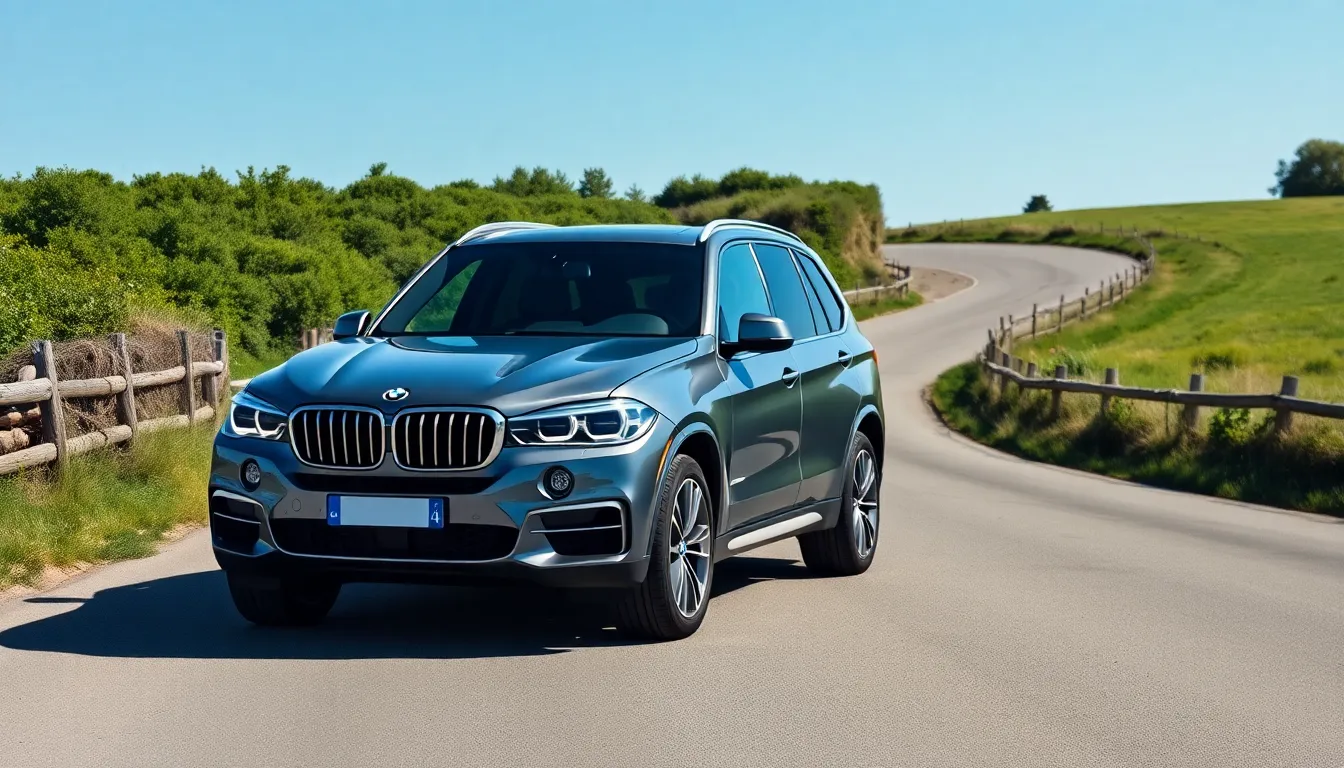
The BMW X5 E53 delivers an exceptional driving experience that combines the elevated seating position of an SUV with BMW’s renowned handling characteristics. We’ve found that this first-generation X5 sets itself apart through precise steering response and confident road manners that feel more like a sport sedan than a traditional SUV.
On-Road Performance
Ever-changing handling capabilities define the E53’s on-road character, with the near-perfect 50:50 weight distribution creating balanced cornering performance. Steering precision remains sharp at highway speeds, while the suspension setup absorbs road imperfections without compromising stability. We observe that the 4.6is model provides the most captivating driving dynamics, with sport-tuned suspension components and enhanced throttle response.
Braking performance proves consistently reliable across all engine variants, with four-wheel disc brakes delivering confident stopping power. The electronic stability control system intervenes smoothly when traction limits approach, maintaining vehicle composure without intrusive intervention. Acceleration characteristics vary significantly between models, with the 3.0i providing adequate power for daily driving while the V8 variants offer genuine performance SUV capabilities.
Highway cruising comfort stands out as a particular strength, with minimal wind noise and refined ride quality at sustained speeds. The E53’s aerodynamic profile contributes to stable high-speed behavior, while the well-insulated cabin maintains a serene environment. Road feedback through the steering wheel provides drivers with clear communication about surface conditions and tire grip levels.
Off-Road Capabilities
Xdrive all-wheel-drive system distributes power effectively across varied terrain conditions, with the electronic traction management adapting to wheel slip situations. Ground clearance of 8.0 inches allows navigation over moderate obstacles, while approach and departure angles accommodate gentle off-road excursions. We note that the E53 handles gravel roads, light trails, and adverse weather conditions with confidence.
Traction control systems work along with the differential locks to maximize grip on loose surfaces. The suspension travel provides adequate articulation for uneven terrain, though the E53’s design prioritizes on-road refinement over extreme off-road capability. Electronic aids like hill descent control assist with steep grade navigation when equipped.
All-terrain tire options expand the E53’s off-road potential significantly compared to standard highway tires. The robust undercarriage protection shields vital components from rock damage during moderate trail use. Winter driving performance excels with the Xdrive system automatically transferring torque between front and rear axles as conditions demand, making the E53 particularly capable in snow and ice conditions.
Reliability and Common Issues
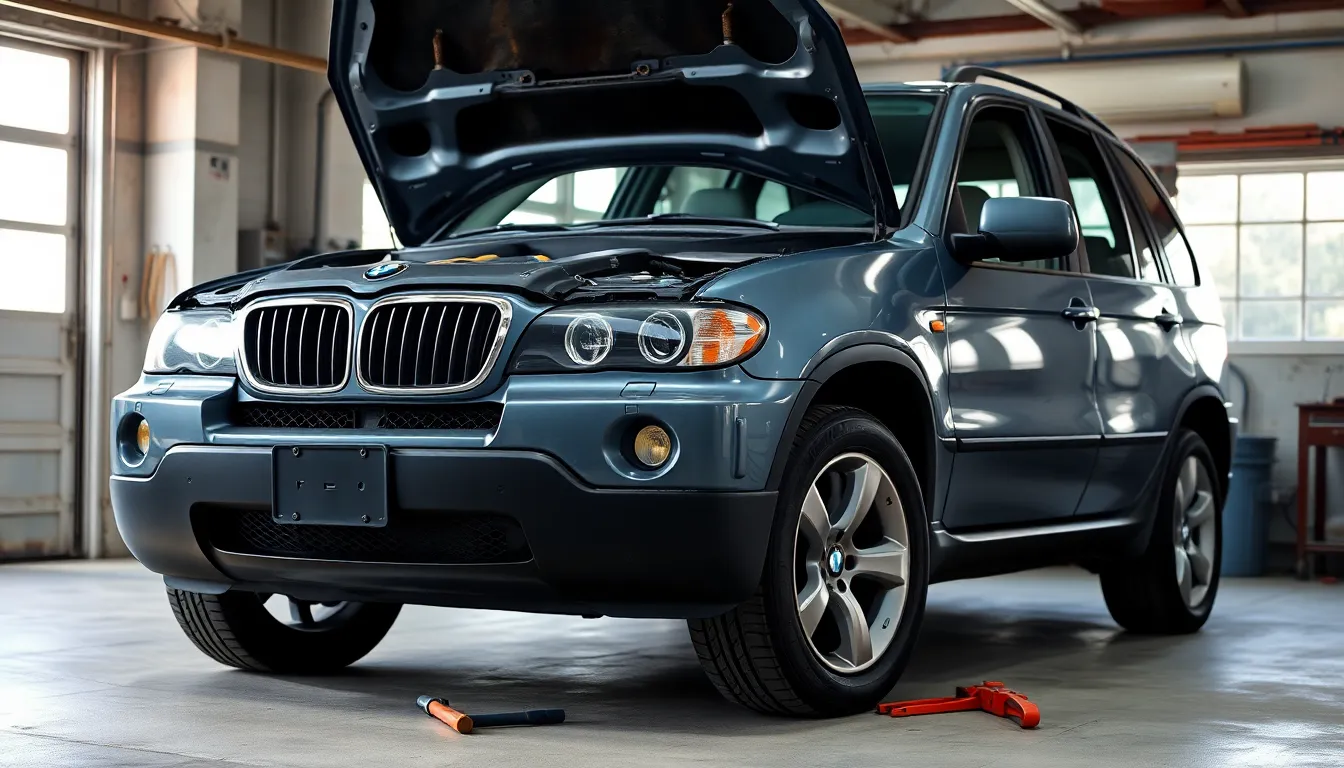
The BMW X5 E53 delivers solid overall reliability when properly maintained, though exact components require attention as these vehicles age. We’ve identified consistent patterns in ownership experiences that help potential buyers make informed decisions.
Known Problems and Answers
Cooling System Components represent the most frequent concern in E53 ownership, with water pumps typically failing between 80,000-120,000 miles. Expansion tanks crack due to plastic degradation, while thermostats stick in closed positions causing overheating. We recommend replacing the entire cooling system as a preventive measure around 100,000 miles, including radiator, water pump, expansion tank, and thermostat simultaneously.
Air Suspension Failures affect models equipped with the optional air suspension system, particularly the air bags and compressor components. Rear air springs leak after 7-10 years, causing uneven ride height and warning lights. Compressors overheat from constant cycling when leaks develop. Converting to conventional coil springs eliminates future air suspension issues while maintaining ride quality.
Transfer Case Chain Stretch occurs in high-mileage examples, creating a rattling noise during startup and low-speed acceleration. Early detection prevents catastrophic failure, though replacement costs range from $2,500-$4,000. Regular transfer case fluid changes every 50,000 miles extend component life significantly.
Window Regulator Motors fail frequently in both front doors, leaving windows stuck in down positions. Plastic clips break within the regulator mechanism, requiring complete assembly replacement. Aftermarket regulators with improved metal clips provide better longevity than OEM plastic versions.
DSC Control Module malfunctions trigger stability control warning lights and reduced engine power modes. Capacitor failure within the module causes intermittent operation, though rebuilt units with upgraded capacitors solve this permanently. We’ve observed this issue primarily in 2003-2006 model years.
Maintenance Costs
Routine Service Intervals require oil changes every 7,500 miles using synthetic oil, costing approximately $80-$120 at independent BMW specialists. Brake fluid changes occur every 24 months at $150, while spark plugs last 60,000 miles requiring $300-$400 for replacement including labor.
Major Service Components include transmission services every 60,000 miles at $400-$600, differential services at $200-$300, and timing chain tensioner replacement around 150,000 miles costing $1,500-$2,200. Air filter changes cost $40-$60, while cabin filter replacement runs $60-$80.
Annual Maintenance Budgets typically range from $1,200-$1,800 for vehicles under 100,000 miles, increasing to $2,000-$3,500 for higher-mileage examples. Independent BMW specialists charge 30-40% less than dealerships while maintaining quality standards. DIY maintenance reduces costs by 50-60% for mechanically inclined owners.
| Service Item | Interval | Cost Range | Notes |
|---|---|---|---|
| Oil Change | 7,500 miles | $80-$120 | Synthetic oil required |
| Brake Fluid | 24 months | $150 | Critical for ABS function |
| Transmission Service | 60,000 miles | $400-$600 | Prevents costly failures |
| Cooling System | 100,000 miles | $1,200-$1,800 | Preventive replacement |
| Air Suspension Repair | As needed | $800-$2,500 | Consider coil conversion |
Warranty Considerations for used E53 purchases include aftermarket extended warranties covering major components like engine, transmission, and electrical systems. Coverage costs $1,500-$3,000 annually but provides peace of mind for expensive repairs. We recommend mechanical inspections before purchase to identify existing issues.
Market Value and Buying Guide
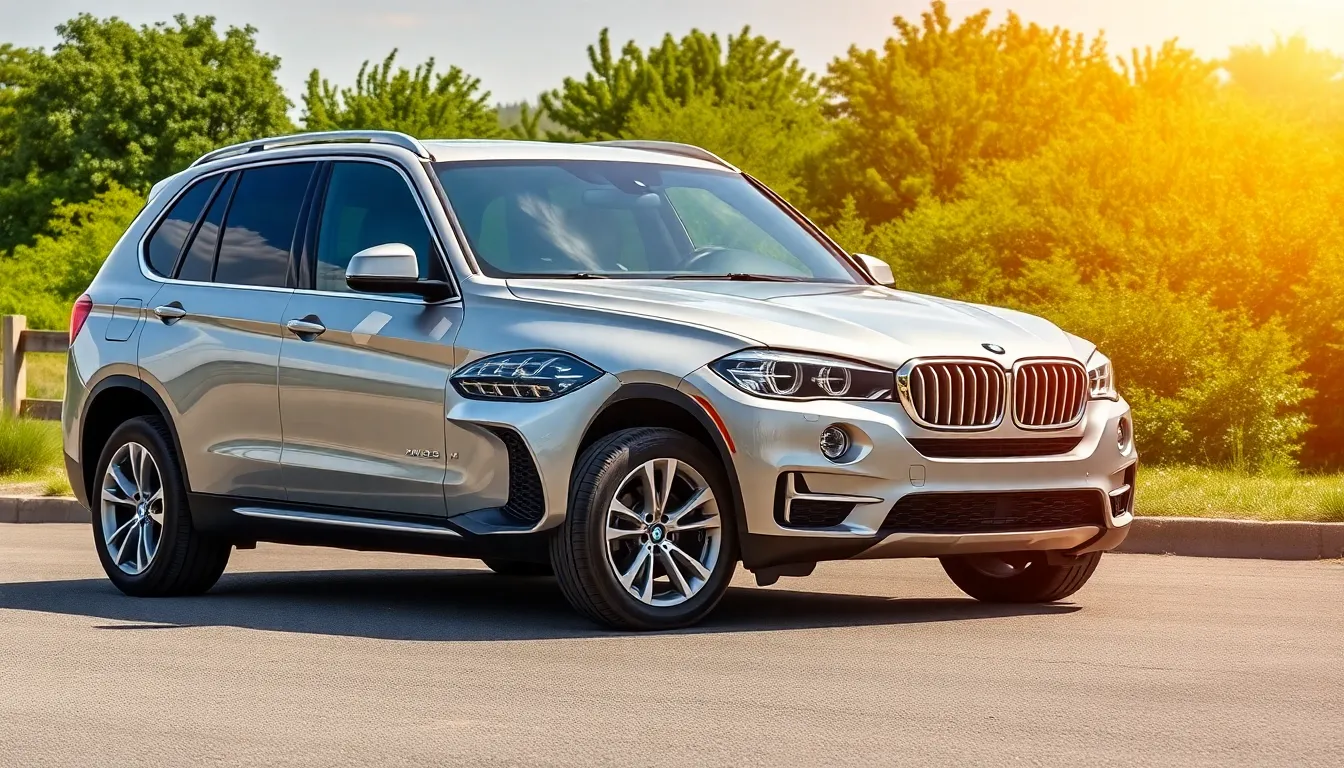
The BMW X5 E53 has evolved into an increasingly attractive proposition in the used luxury SUV market. Current values reflect both its historical significance as the inaugural X5 model and its continued appeal among enthusiasts seeking authentic BMW driving dynamics.
Current Pricing Trends
Market analysis reveals important price variations based on mileage condition and model year for the X5 E53. Base 3.0i models typically range from $8,000 to $15,000 depending on maintenance history and overall condition. Mid-tier 4.4i variants command prices between $12,000 and $22,000 with well-maintained examples reaching the upper end of this spectrum.
The rare 4.6is model represents the premium segment of E53 pricing with values spanning $18,000 to $35,000 for exceptional examples. Low-mileage 4.6is models with comprehensive service records often exceed $30,000 particularly when equipped with desirable options like sport packages or premium interior treatments.
| Model Variant | Price Range | Average Mileage | Market Position |
|---|---|---|---|
| 3.0i | $8,000 – $15,000 | 120,000 – 180,000 | Entry Level |
| 4.4i | $12,000 – $22,000 | 100,000 – 160,000 | Mid-Tier |
| 4.6is | $18,000 – $35,000 | 80,000 – 140,000 | Premium |
Regional factors influence X5 E53 pricing with vehicles from southern climates commanding premiums due to reduced rust exposure. Examples with documented dealer service history typically sell for 15% to 20% above comparable privately maintained vehicles.
What to Look for When Buying
Cooling system integrity represents the most critical inspection point when evaluating any X5 E53. Examine the expansion tank for cracks particularly around the neck and overflow areas where stress fractures commonly develop. Temperature gauge behavior during test drives reveals cooling system health with any fluctuation indicating potential radiator or water pump issues.
Transfer case operation requires thorough evaluation through careful listening during acceleration and turning maneuvers. Chain stretch produces characteristic whining noises that intensify under load particularly during highway merging or steep incline climbing. Budget approximately $3,000 to $4,500 for transfer case replacement when this issue presents itself.
Air suspension systems demand comprehensive testing across all height settings and driving modes. Compressor cycling frequency indicates system health with excessive operation suggesting leaks in air springs or lines. Ride height inconsistencies between corners often signal individual air spring failure requiring replacement costing $800 to $1,200 per corner.
Electronic systems inspection includes verifying iDrive functionality navigation accuracy and climate control operation. Window regulator mechanisms frequently fail on E53 models creating safety concerns and repair costs ranging from $400 to $600 per affected window. Dashboard pixel fade affects instrument cluster readability but remains primarily cosmetic unless speedometer becomes illegible.
Service documentation review provides crucial insight into previous maintenance quality and frequency. Comprehensive records indicating timely oil changes transmission services and brake system maintenance suggest responsible ownership and reduced future repair likelihood. Missing maintenance history typically correlates with deferred repairs and higher ownership costs.
Conclusion
The BMW X5 E53 remains a compelling choice for luxury SUV enthusiasts who value German engineering and driving dynamics. We’ve seen how this pioneering model successfully bridged the gap between performance and practicality while establishing BMW’s presence in the SUV market.
Even though its age the E53 continues to offer exceptional value in today’s used car market. With proper maintenance and careful selection buyers can enjoy years of reliable service from this automotive milestone.
Whether you’re drawn to the balanced 3.0i the powerful 4.4i or the rare 4.6is variant the X5 E53 delivers an ownership experience that few competitors can match. We believe this first-generation X5 represents one of the best entries into luxury SUV ownership for discerning buyers.
Frequently Asked Questions
What years was the BMW X5 E53 produced?
The BMW X5 E53 was produced from 1999 to 2006. This first-generation model marked BMW’s entry into the luxury SUV market and established the foundation for their Sports Activity Vehicle lineup that continues today.
What engine options were available in the BMW X5 E53?
The E53 offered three engine options: the 3.0i with a 231-horsepower inline-six, the 4.4i with a 290-horsepower V8, and the high-performance 4.6is introduced in 2002 with 347 horsepower. The 4.6is could accelerate from 0-60 mph in just 5.3 seconds.
What are the dimensions of the BMW X5 E53?
The X5 E53 measures 183.7 inches long, 73.7 inches wide, and 68.6 inches tall with 8.0 inches of ground clearance. It offers up to 71.1 cubic feet of cargo capacity and features a near-perfect 50:50 weight distribution for enhanced handling.
What are common reliability issues with the BMW X5 E53?
Common issues include cooling system failures, air suspension problems, and transfer case chain stretch. Regular maintenance is crucial, with particular attention needed for the cooling system, suspension components, and drivetrain elements to ensure long-term reliability.
How much does a used BMW X5 E53 cost?
Current market prices vary by model: base 3.0i variants range from $8,000-$15,000, mid-tier 4.4i models cost $12,000-$22,000, and the rare high-performance 4.6is commands $18,000-$35,000 for exceptional examples.
What should I inspect when buying a BMW X5 E53?
Focus on cooling system integrity, transfer case operation, air suspension functionality, and electronic systems. Check service documentation thoroughly, as proper maintenance history is crucial for assessing the vehicle’s condition and future reliability.
Does the BMW X5 E53 have good off-road capabilities?
Yes, the E53 features BMW’s xDrive all-wheel-drive system that effectively handles moderate off-road obstacles and adverse weather conditions. Combined with 8.0 inches of ground clearance, it offers solid capability for light off-road adventures.
What makes the BMW X5 E53 historically significant?
The E53 revolutionized the luxury SUV market by combining BMW’s renowned performance and handling with family-friendly practicality. It established the blueprint for modern luxury SUVs and marked BMW’s successful expansion beyond traditional sedans and coupes.

